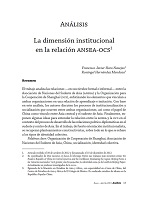La dimensión institucional en la relación ANSEA-OCS
DOI:
https://doi.org/10.32870/mycp.v2i3.396Palabras clave:
Organización de Cooperación de Shanghai, Asociación de Naciones del Sudeste de Asia, China, socialización, identidad colectiva.Resumen
El trabajo analiza las relaciones —en sus niveles formal e informal— entre la Asociación de Naciones del Sudeste de Asia (ANSEA) y la Organización para la Cooperación de Shanghai (OCS), enfatizando los elementos que vinculan a ambas organizaciones en una relación de aprendizaje e imitación. Con base en este análisis, los autores discuten los procesos de institucionalización y socialización que ocurren entre ambas organizaciones, así como el papel de China como vínculo entre Asia central y el sudeste de Asia. Finalmente, exponen algunas ideas para entender la relación entre la ansea y la OCS en el contexto del proceso de desarrollo de las relaciones político-diplomáticas en el sudeste y centro de Asia. En el trabajo, de fuerte orientación institucionalista, se recuperan planteamientos constructivistas, sobre todo en lo que se refiere a los tipos de identidad colectiva. Abstract:This paper analyzes the formal and informal relations between the Association of Southeast Asian Nations (asean) and the Shanghai Cooperation Organization (sco). It emphasizes elements which link the two organizations in a relationship of learning and imitation. Based on this analysis, the authors discuss the institutionalization and socialization processes that occur between the two organizations, as well as China’s role as a link between Central and Southeast Asia. Finally, they introduce some ideas for understanding the relationship between asean and sco in the context of the development of political and diplomatic relations in Southeast and Central Asia. The paper has a strong institutionalist orientation and it employs constructivist approaches, especially regarding the types of collective identityDescargas
Citas
Acharya, Amitav (1999), “Realism, Institutionalism, and the Asian Economic Crisis”, Contemporary Southeast Asia, vol. 21, núm. 1, pp. 1-29.
Aris, Stephen (2009), “A New Model of Asian Regionalism: does the Shanghai Cooperation Organization have more potential than asean?”, Cambridge Review of International Affairs, vol. 22, núm. 3, pp. 451-467.
ASEAN(2007), Chairperson’s Statement of the 12th asean Summit H.E. the President Gloria Macapagal Arroyo: “One caring and sharing community” (Cebu, Philippines, 13 January 2007). Disponible en: http://www.aseansec.org/19280.htm (consultado el 18 de octubre de 2012).
Beijing Review (1994), “China’s Basic Policy towards Central Asia”, Beijing Review, vol. 37, núm. 18, pp. 18-19. CCTV.COM English (2012), “Joint sco military drill concludes with a success”, (15 de junio de 2012). Disponible en: http://english.cntv. cn/20120615/106726.shtml. Fecha de consulta: octubre 20, 2012).
China.org.cn (2003), “China, Philippines Issue Joint Communique on Relations, World Issues”, (1º de septiembre de 2003). Disponible en: http:// www.china.org.cn/english/international/73968.htm. Fecha de consulta: octubre 18, 2012).
Dadabaev, Timur (2007), “Central Asian Regional Integration: Between Reality and Myth”, caci Analyst, (2 de febrero de 2007). Disponible en: www.cacianalyst.org/newsite/?q=node/4604. Fecha de consulta: octubre 18, 2012.

Publicado
Cómo citar
Número
Sección
Licencia
Política de acceso abierto
Esta revista proporciona un acceso abierto a su contenido, fiel al principio de que ofrecer al público un acceso libre a las investigaciones ayuda a un mayor intercambio global del conocimiento.
MyCP se publica bajo la licencia de Creative Commons Reconocimiento-No Comercial CC BY-NC
Los contenidos serán publicados en versión PDF y XML.
Los autores(as) que publiquen en México y la Cuenca del Pacífico aceptan las siguientes condiciones:
De acuerdo con la legislación de derechos de autor, México y la Cuenca del Pacífico reconoce y respeta el derecho moral de los autores(as), así como la titularidad del derecho patrimonial, mismo que será cedido a la Universidad de Guadalajara para su difusión en acceso abierto.
México y la Cuenca del Pacífico no realiza cargos a los autores(as) por enviar y procesar artículos para su publicación.
Los autores(as) pueden realizar otros acuerdos contractuales independientes y adicionales para la distribución no exclusiva de la versión del artículo publicado en México y la Cuenca del Pacífico (por ejemplo, incluirlo en un repositorio institucional o darlo a conocer en otros medios en papel o electrónicos) siempre que indique clara y explícitamente que el trabajo se publicó por primera vez en México y la Cuenca del Pacífico.
Una vez que se acepte el artículo para su publicación los autores(as) deben remitir el formato de carta-cesión de derechos de la publicación debidamente requisitado y firmado por los autores(as). Este formato debe ser remitido en archivo PDF paralelamente con la versión final del artículo al correo: mexicoylacuenca@gmail.com.
Los lectores/usuarios de México y la Cuenca del Pacífico pueden acceder directamente al contenido de manera libre y gratuita en todo momento, incluyendo cuando un nuevo número es colocado en la plataforma. Se permite al lector/usuario citar, compartir (electrónicamente y de manera física), imprimir y distribuir el material siempre que se indique de manera clara y explícitamente que el trabajo se publicó por primera vez en México y la Cuenca del Pacífico. Es necesario citar de manera correcta el trabajo y no debe de ser utilizado con fines comerciales.




